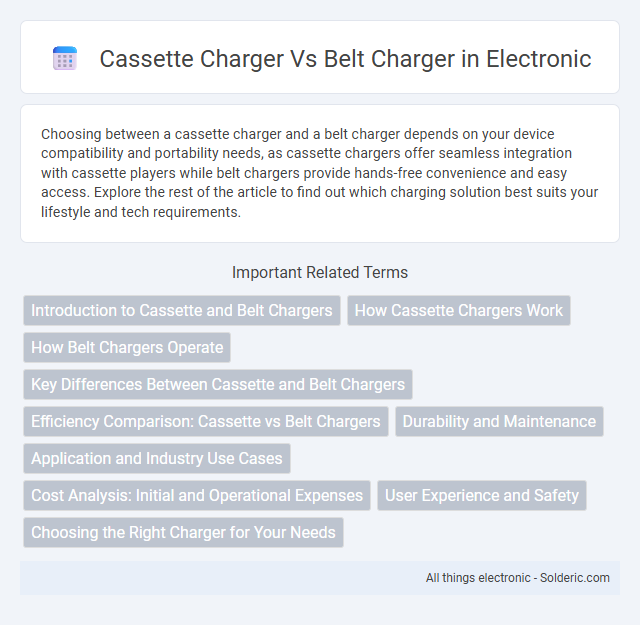Choosing between a cassette charger and a belt charger depends on your device compatibility and portability needs, as cassette chargers offer seamless integration with cassette players while belt chargers provide hands-free convenience and easy access. Explore the rest of the article to find out which charging solution best suits your lifestyle and tech requirements.
Comparison Table
| Feature | Cassette Charger | Belt Charger |
|---|---|---|
| Design | Compact, cassette-shaped | Wearable, belt-mounted |
| Portability | Moderate, fits in bag | High, hands-free use |
| Charging Method | Stationary charging | On-the-go charging |
| Usage Scenario | Indoor, fixed location | Outdoor, mobile activities |
| Power Output | Standard, up to 10W | Variable, typically up to 15W |
| Battery Integration | External or internal | Usually integrated with charger belt |
| Price Range | Affordable to mid-range | Mid-range to premium |
Introduction to Cassette and Belt Chargers
Cassette chargers and belt chargers are specialized battery charging devices used primarily in industrial and automotive settings, designed to optimize the charging process for different battery types. Cassette chargers typically provide modular, portable charging solutions that can be easily swapped or transported, while belt chargers are integrated into conveyor or assembly lines for continuous, automated charging. Understanding the differences between these chargers helps you select the right device for efficient battery maintenance and operational reliability.
How Cassette Chargers Work
Cassette chargers operate by integrating a compact charging module directly into a cassette tape player, using the device's built-in power source to deliver energy to compatible electronic devices via USB or specialized connectors. This design allows users to charge smartphones and other gadgets efficiently while driving, leveraging the cassette slot without additional wiring or power adapters. The magnetic tape head inside the cassette charger converts rotational motion into electrical power, enabling seamless on-the-go charging through the car's existing cassette deck.
How Belt Chargers Operate
Belt chargers operate by securely fastening around the user's waist, providing easy access and portability for charging devices on the go. They typically feature multiple compartments and USB ports, allowing simultaneous charging of various gadgets while maintaining hands-free convenience. This design enhances mobility compared to cassette chargers, which are bulkier and less ergonomic for active use.
Key Differences Between Cassette and Belt Chargers
Cassette chargers integrate seamlessly into a cassette-style housing, making them compact and ideal for discreet charging applications, while belt chargers are designed as wearable, flexible devices that attach directly to belts or clothing for hands-free use. Cassette chargers often offer higher energy density and better protection due to their enclosed design, whereas belt chargers prioritize portability and ease of access in dynamic environments. The choice between these depends on user preference for device placement, durability requirements, and the specific charging scenario.
Efficiency Comparison: Cassette vs Belt Chargers
Cassette chargers deliver higher energy transfer efficiency by minimizing heat loss during charging cycles, making them ideal for prolonged device use. Belt chargers, while more portable, often experience energy dissipation due to their compact design, resulting in less efficient power delivery. Choosing the right option impacts Your charging speed and device longevity, with cassette chargers generally providing superior performance in efficiency metrics.
Durability and Maintenance
Cassette chargers typically offer enhanced durability due to their sealed design, protecting internal components from dust and moisture, which reduces maintenance frequency. Belt chargers, while convenient, often expose wiring and connectors to wear and tear, increasing the need for regular inspection and repairs. Choosing a cassette charger can extend your device's lifespan and minimize downtime caused by maintenance issues.
Application and Industry Use Cases
Cassette chargers are widely used in manufacturing and assembly lines for battery-powered tools, providing quick and efficient recharging in compact spaces. Belt chargers are favored in logistics and field service industries due to their portability and ease of attachment, enabling continuous use of equipment like handheld scanners and communication devices. Both types optimize workflow by matching the energy needs of specific industrial applications, enhancing productivity and minimizing downtime.
Cost Analysis: Initial and Operational Expenses
Cassette chargers typically have a higher initial cost due to complex installation requirements and advanced technology integration, while belt chargers offer a more affordable upfront investment with simpler setup. Operational expenses for cassette chargers may be lower over time because of enhanced energy efficiency and reduced maintenance needs, whereas belt chargers might incur higher ongoing costs through frequent upkeep and energy consumption. Your choice hinges on balancing the upfront budget with long-term operational savings for optimal cost efficiency.
User Experience and Safety
Cassette chargers provide a compact, enclosed design that minimizes cable clutter and reduces the risk of tripping hazards, enhancing overall user safety. Belt chargers offer quick accessibility and ease of use during active movement, making them ideal for users who need portable charging on the go. Your choice between the two should consider whether convenience or safety is the priority in your specific environment.
Choosing the Right Charger for Your Needs
Choosing between a cassette charger and a belt charger depends on portability and power requirements. Cassette chargers, designed for in-car use with 12V sockets, offer convenience for charging devices on the go. Belt chargers provide hands-free, wearable solutions ideal for workers or athletes needing constant access to power without restricting movement.
Cassette charger vs Belt charger Infographic

 solderic.com
solderic.com